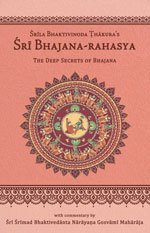Bhajana-Rahasya
by Srila Bhaktivinoda Thakura Mahasaya | 2010 | 123,965 words
The Bhajana-rahasya Text 7, English translation, including commentary (vritti). The Bhajana-rahasya is a compilation of verses describing the mercy of the eight pairs of names (Yugala-nama) of the Maha-mantra. This is text 7 belonging to the chapter “Dvitiya-yama-sadhana (Pratah-kaliya-bhajana)” representing the first six dandas of the morning: approximately 6.00 a.m.–8.30 a.m.
Text 7
Anarthas, or misfortune, are of four kinds. This is described in the Āmnāya-sūtra-vyākhyā:
माया-मुग्धस्य जीवस्य ज्ञेयो’नर्थश् चतुर्-विधः
हृद्-दौर्बल्यं चापराधो ’सत्-तृष्णा तत्त्व-विभ्रमःmāyā-mugdhasya jīvasya jñeyo’narthaś catur-vidhaḥ
hṛd-daurbalyaṃ cāparādho ’sat-tṛṣṇā tattva-vibhramaḥThe anarthas of the living entities enchanted by the illusory energ y are of four kinds: (1) illusion about one’s real identity (svarūpa-bhrama), (2) hankering for what is temporary (asat-tṛṣṇā ), (3) offences (aparādha) and (4) weakness of heart (hṛdayadaurbalya ). They bind the living entity to the material world and entangle him in its miseries.
माया-मुग्ध जीवेर अनर्थ चतुष्टय
असत्-तृष्णा, हृदय-दौर्बल्य विषमयmāyā-mugdha jīvera anartha catuṣṭaya
asat-tṛṣṇā, hṛdaya-daurbalya viṣamayaअपराध स्वरूप-विभ्रम एइ चारि
याहाते संसार-बन्ध विपत्ति विस्तारिaparādha svarūpa-vibhrama ei cāri
yāhāte saṃsāra-bandha vipatti vistāri
Commentary: Bhajana-rahasya-vṛtti:
The living entities seized by māyā and derailed from pure dharma wander in this material existence, falsely thinking they are its enjoyers. Four anarthas are noticed in these living entities: svarūpa-bhrama, asat-tṛṣṇā, aparādha and hṛdaya-daurbalya. Anarthas are the collection of that which has no purpose. The jīva’s only purpose is service to Śrī Kṛṣṇa, but in this material existence he is engaged in māyā’s service–hence, this is an anartha.
Svarūpa-bhrama–The pure living entity is a tiny transcendental particle (cid-aṇu) and the eternal servant of Śrī Kṛṣṇa. Just as the conditioned living entity experiences form, taste, smell, touch, etc. through his material senses, the pure living entity experiences transcendental form, taste and so forth through his transcendental senses. Forgetting that “I am an infinitesimal particle of spiritual consciousness and Kṛṣṇa’s servant” the jīva becomes conditioned and wanders about in this material existence. The primary anartha of the living entity is his failure to realise his svarūpa, his true nature.
Asat-tṛṣṇā–To consider the material body to be ‘me’, to consider perishable objects in relation to the body to be ‘mine’, and to desire happiness from perishable objects, is called asat-tṛṣṇā.
Aparādha–Apagata-rādho yasmād ity aparādhaḥ. Rādha means affection (prīti), so that action which causes affection to vanish is called aparādha (offence). Aparādha at the lotus feet of the Supreme Lord and at the lotus feet of His devotees decreases prīti. One should avoid the ten nāma-aparādhas, the thirty-two sevāaparādhas and all the dhāma-aparādhas.
Hṛdaya-daurbalya–When the heart experiences illusion and distress upon the attainment or loss of that which is perishable, it is called hṛdaya-daurbalya, weakness of heart. This anartha appears naturally in the living entity due to ignorance, and it vanishes by the cultivation of Kṛṣṇa consciousness in the association of pure devotees.
